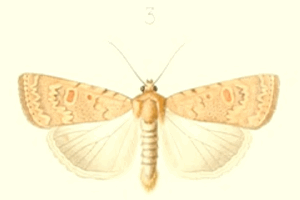
The Noctuidae, commonly known as owlet moths, cutworms or armyworms, are a family of moths. They are considered the most controversial family in the superfamily Noctuoidea because many of the clades are constantly changing, along with the other families of the Noctuoidea. It was considered the largest family in Lepidoptera for a long time, but after regrouping Lymantriinae, Catocalinae and Calpinae within the family Erebidae, the latter holds this title now. Currently, Noctuidae is the second largest family in Noctuoidea, with about 1,089 genera and 11,772 species. This classification is still contingent, as more changes continue to appear between Noctuidae and Erebidae.

Drasteria is a genus of moths in the family Erebidae.
Teinoptera is a genus of moths of the family Noctuidae.
Anydrophila stuebeli is a moth of the family Noctuidae first described by Heinrich Wilhelm Calberla in 1891. It is found in the Sinai, Egypt, central Arabia, the United Arab Emirates, Jordan and Israel.
Leucania herrichii is a species of moth in the family Noctuidae. It was described by German entomologist Gottlieb August Wilhelm Herrich-Schäffer in 1849 as Mythimna herrichii. It can be found in Bulgaria, Croatia, Cyprus, Egypt (Sinai), Greece, Iran, Israel, Italy (Sicily), Jordan, Lebanon, Palestine, Syria, Turkey, and Turkmenistan. Adults have a wingspan of approximately 30–36 mm (1.2–1.4 in), and the larvae likely feed on grasses.
Metalopha gloriosa is a moth of the family Noctuidae first described by Otto Staudinger in 1887. It is found from western Turkey to eastern Taurus Mountains, Iraq, Anatolia, Israel, Jordan, Lebanon and Syria.
Calophasia angularis is a moth of the family Noctuidae. The species was first described by Pierre Chrétien in 1911. It is found from the western parts of the Sahara and Morocco throughout all North Africa, Riyadh, Israel, Jordan and Turkmenistan.
Cleonymia fatima is a moth of the family Noctuidae first described by Andreas Bang-Haas in 1907. It is found in Algeria, Tunisia, Libya, Jordan and Israel.
Teinoptera gafsana is a moth of the family Noctuidae first described by Charles Theodore Blachier in 1905. It is found from Morocco through all north-western Africa to Libya. It is also found in the central Arabian deserts, Iraq and Israel.
Teinoptera olivina is a moth of the family Noctuidae. It is found in Morocco, Spain, France, Switzerland, Italy, Austria, Yugoslavia, North Macedonia, Romania, Bulgaria, Albania, Greece, Turkey, Algeria, Tunisia, Arabia and Saudi Arabia.
Teinoptera lunaki is a moth of the family Noctuidae. It is found in Yugoslavia, North Macedonia, Bulgaria and Greece.
Teinoptera oliva is a moth of the family Noctuidae. It is found in Greece, Turkey, Syria, Armenia and Transcaucasia.
Rhabinopteryx subtilis is a moth of the family Noctuidae. The species was first described by Paul Mabille in 1888. It is found from Morocco along the northern African coast of the Mediterranean Sea to Egypt, the Arabian Peninsula, Iraq, Iran and Israel.

Heliothinae is a small, cosmopolitan subfamily of moths in the family Noctuidae, with about 400 described species worldwide. It includes a number of economically significant agricultural pest species, such as Helicoverpa armigera and Helicoverpa zea.

The Erebinae are a subfamily of moths in the family Erebidae erected by William Elford Leach in 1815. Erebine moths are found on all continents except Antarctica, but reach their greatest diversity in the tropics. While the exact number of species belonging to the Erebinae is not known, the subfamily is estimated to include around 10,000 species. Some well-known Erebinae include underwing moths (Catocala) and witch moths (Thermesiini). Many of the species in the subfamily have medium to large wingspans, up to nearly 30 cm in the white witch moth, which has the widest wingspan of all Lepidoptera. Erebine caterpillars feed on a broad range of plants; many species feed on grasses and legumes, and a few are pests of castor bean, sugarcane, rice, as well as pistachios and blackberries.

Caradrina flava is a moth of the family Noctuidae. It was described by Charles Oberthür in 1876. It is found in Spain and Greece and on Malta and the Canary Islands, as well as from the Sahara to the Arabian Peninsula, Israel, Jordan, the Levant, Iran and Iraq.

Caradrina selini is a moth of the family Noctuidae. It was described by Jean Baptiste Boisduval in 1840. It is found in most of Europe, North Africa and the Near East.
Eublemma amabilis is a moth of the family Noctuidae first described by Saalmüller in 1891. It is found in India, Bangladesh and Sri Lanka.





